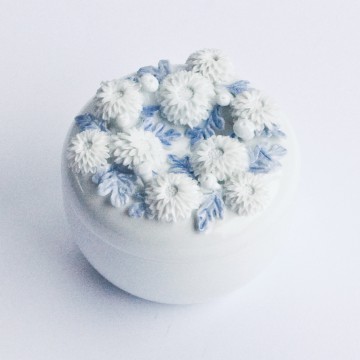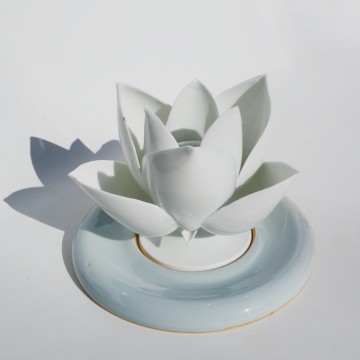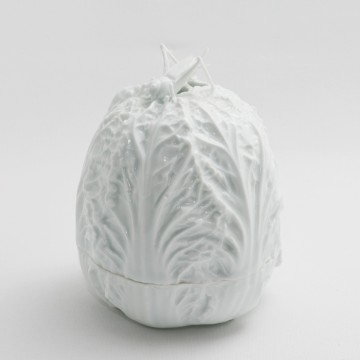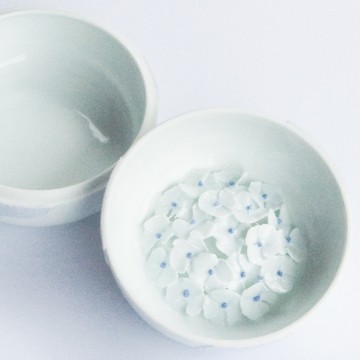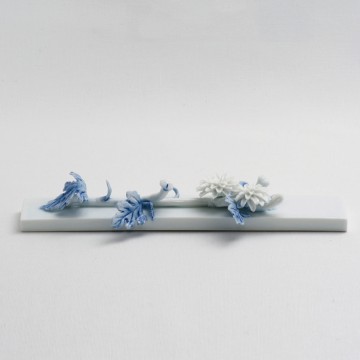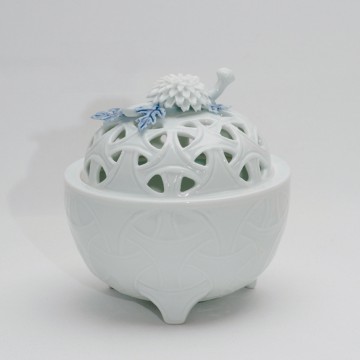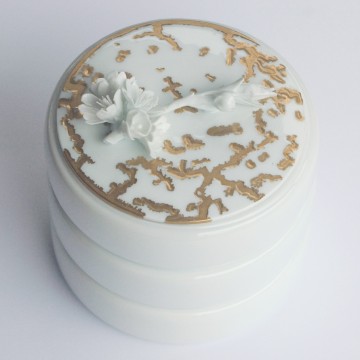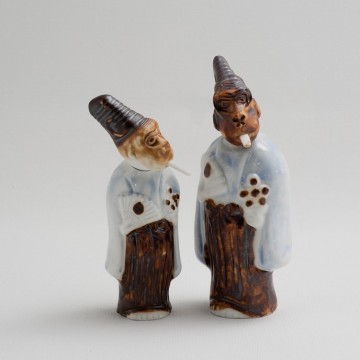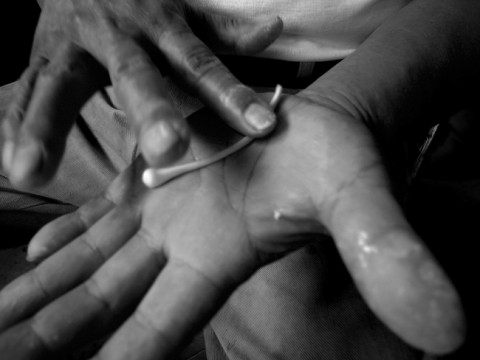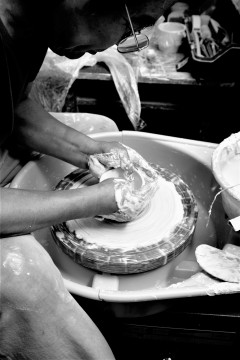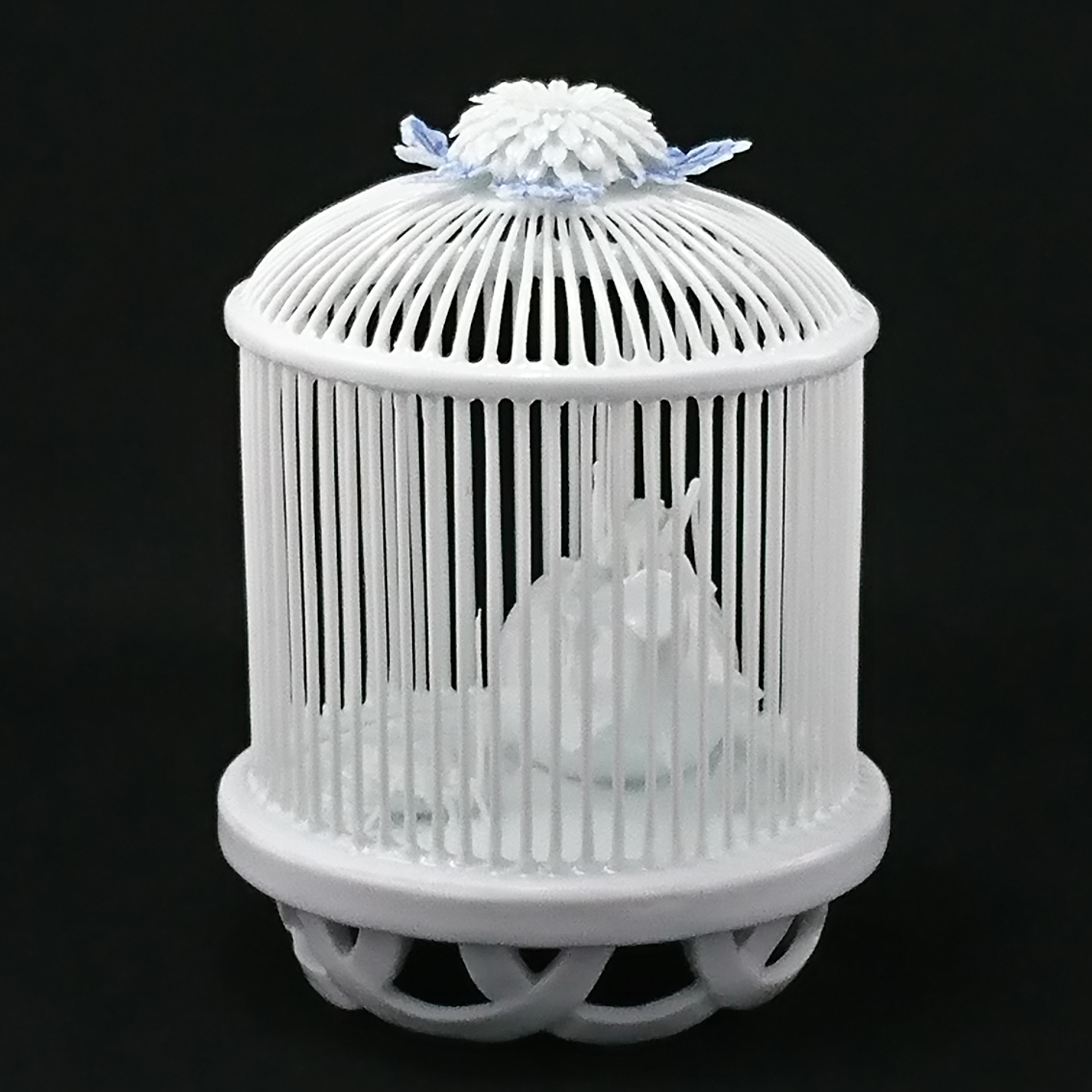
At the beginning of the Edo period, Hitoshi Imamura, the 14th generation Hirado Etsuyama, was born in a kiln whose ancestor was “Nyosaru,” who succeeded in making pure white porcelain. Following and developing traditional techniques, we have established an outstanding “twisting technique” that surpasses our predecessors.
By himself, he consistently produces all the processes from design, wheel, work, and baking without dividing the work, and creates a new beauty of modeling that was not in the heyday of twisting work technology in the Meiji era.
■ Session: November 25th (Wednesday) -December 1st (Tuesday), 2020
■ Venue: Seibu Ikebukuro Main Store 6th Floor (Central B8) = Seibu Art Forum
* On the final day, December 1st (Tuesday), only the venue will close at 4 pm.
Hirado ware is the same old porcelain producing area as Arita ware and Hasami ware, and has a history of about 400 years. We will exhibit and sell 68 works by Etsuyama Hirado (Mr. Hitoshi Imamura), the 14th kiln owner of “Hirado Kiln Etsuyama”, a kiln that has made porcelain for generations as a kiln for the Hirado Domain in Sasebo City, Nagasaki Prefecture.
Hitoshi Imamura has outstanding skills, and in particular, the twisting technique was designated as an intangible cultural property designated by Sasebo City in 2014 as an advanced craft technique that was inherited and developed.
Take a closer look at the beauty of the transparent thin white porcelain and the unique modeling created by transcendental techniques.
White porcelain work “Chrysanthemum decoration insect cage” (Suzumushi)
Size: Diameter 12.0 x Height 15.5 cm
It was created with the idea of a culture that enjoys the cry of insects, which is said to have been around since the Nara period.
The base of the insect cage is made into a wheel and carved. In the insect cage, there is an eggplant and a bell worm. After the potter’s wheel, the eggplant is twisted, and the numbered bell worm is also twisted using the fingertips. Bamboo strips with a thickness of about 2 mm are made into pillars with a round roof with a circumference of about 60 pieces.
The dome of the dome has a thin twist in the direction toward the center to express the entire basket beautifully and delicately. The decoration in the center is made by twisting a chrysanthemum flower, which has been believed to have the power to dispel evil since the Heian period. It is a gem of transcendental technique that is baked in one piece by estimating all shrinkage from molding to baking.
“Chrysanthemum exhaustion bonbonnière”
Diameter 10.5 x height 8.5 cm
A white porcelain bonbonniere with chrysanthemums that wish for longevity placed on the lid. Kikuhana is made by one of the traditional twisting techniques called chrysanthemum work.
Using a bamboo spatula from the lump about the tip of your thumb, raise the petals one by one and carve chrysanthemums. It is a container for small sweets, which is used as an item to celebrate the celebration.
White porcelain work “White Dragon”
Size: Diameter 22.0 x Height 24.5 cm
White dragons have served the emperor of the heavenly world in ancient Chinese legend. In Japan, it has been regarded as the sacred guardian deity of the west. The large jewel of the white dragon is ground into a hollow shape by the potter’s wheel and finished by shaving.
On the jewel, a dragon is shaped by twisting and a thousand scales are applied. Use the palm and fingertips of each of the horns, fangs, nails, and eyelashes to create sharp areas, and look at the folds to add facial expressions. Estimate the shrinkage from molding of jewels and crafting of white dragons to baking, and bake them all together. It is a gem of the whole body, the beauty of strength that survived the flame of 1300 degrees.
“Koren”
Size: Diameter 17.5 x Height 12.5 cm
The lotus of Etsuyama Hirado, the 14th generation, grinds all parts with a potter’s wheel. The petals are made by grinding a thin sphere, dividing the part that becomes the petal from the sphere into two or three parts, and twisting it to make the petals. It is produced by the process of pasting petals molded around a tentacle (Hachisu). The lotus work, which is attractive for the overlapping curves created from multiple potter’s wheel moldings, is a graceful gem unique to the 14th generation Hirado Etsuyama.
What is a tongue out Sanban doll?
In 1664, the lord of the Hirado domain gave the third generation “Yajiro Imamura”, who succeeded in firing pure white porcelain, the name “Nyosaru”. Since his dark-skinned appearance resembled a monkey, he didn’t feel like a monkey, so he made a doll with a monkey that jumped Sanbansho and put out his tongue, and presented it to the feudal lord. The fun of turning the neck and sticking out the tongue was well received not only by the feudal lord but also by the Dutch who were staying at Dejima in Nagasaki, and it was exported in large quantities. It was exhibited at the 1867 Paris Exposition, and was bought by the eyes of Empress Eugénie of Napoleon III. It was inherited and exported even after the Meiji era when the kiln was abolished. It is still handmade in the Hirado kiln using the old technique of Ichiko Soden.
14th generation Etsuyama Hirado Hitoshi Imamura Profile
Born in Oriose Village, Higashisonogi County, Nagasaki Prefecture (currently Mikawachi Town, Sasebo City) in 1942.
1961 Studied under potter Natsuyama Takatsuru to improve pottery skills. Under the guidance of the 12th generation Etsuyama and Kao Imamura
1980 Received the Chairman’s Award of the 4th National Traditional Crafts Exhibition Traditional Crafts Industry Promotion Association (hereinafter, the 5th and 6th Awards)
1982 “Edo Komon White Porcelain Sencha” PAC’82 Fukuoka Trade Bureau Director’s Award
1985 “Emperor Sake Cup” presented by Mayor Sasebo of the Consulate General of China to Consul General Wang Zhenyu
1992 “Hitoshi Imamura Exhibition” Held a solo exhibition at Nagasaki NBC Socia Gallery
1993 “Chrysanthemum picker tub water finger” Nagasaki Prefectural Art Museum collection
2002 “Sanryo Plate” Thank you for visiting our Majesties the Emperor and Empress during Yukihiro Nagasaki.
2006 “lotus” Richard Ginori Museum of Ceramics Collection / Florence, Italy
2010 Solo exhibition at “14 ° Hirado Etsuzan” Church of Saint Roch / Ghemme, Piedmont, Italy
2013 “14th Hirado Etsuyama KAKUF USA Exhibition” Art Gallery / Hotel Chinzanso Tokyo (held every year until 2019)
2013 “White Dragon” “Insect Cage (Suzumushi)” Exhibition The Dolder Grand Hotel / Zurich, Switzerland (until 2016)
2014 White porcelain work “White Dragon” Thank you for visiting the Crown Prince Yukihiro Nagasaki.
2014 “Kakufusa Porcelain” Boutique & Showroom / Cruise Liner M / V The World (Same as 2017)
2017 “Takanawakai” exhibition / Grand Prince Hotel Takanawa / RIHGA Royal Hotel Osaka.
2017 “14th Hirado Etsuyama Exhibition” Fujita Museum Hall
Celebrating the throne of His Majesty the Emperor in 2019, the 14th generation Hirado Etsuyama Sasa made white porcelain “ Kikuhana insect cage” presented from Nagasaki Prefecture Currently a holder of intangible cultural properties designated by Sasebo City
About measures for prevention of new coronavirus infection at Seibu Ikebukuro Main Store
When holding various events and exhibitions, we ask customers to wear masks, disinfect their hands, and secure social distance, as well as to thoroughly prevent the spread of infection in facilities and employees. If you are not feeling well or have a fever We kindly ask for your cooperation in refraining from visiting the venue.


